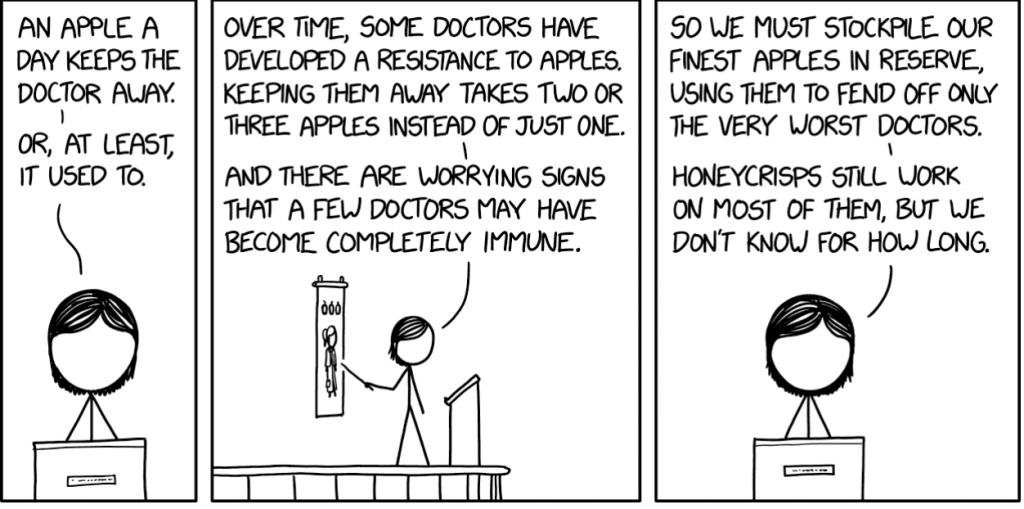We all know the saying: an apple a day keeps the doctor away. This adage has been around in some form since 1860. In fact, the original saying was “eat an apple on going to bed, and you’ll keep the doctor from earning his bread” [1]. Shockingly, the LCME requirements for medical school curricula make no mention of apples, an apparent threat to the medical profession [2]. In all seriousness (but not really), the old saying got me thinking about how apples can affect a doctor’s wellbeing.
Let’s say, for argument’s sake, that the “apple a day” saying is true, and that eating an apple every day keeps a person in perfect health. Then are apples as cost-effective as physicians? The average U.S. physician in 2018 took home $290,000 annually, and there are approximately 900,000 of them [3,4]. Red Delicious apples (clearly a misnomer) are usually the cheapest in the grocery store, costing about 40 cents for a 0.33 pound apple [5]. For 330 million Americans to eat a Red Delicious daily for a year, the bill would amount to $48.2 billion. The sum total of American physicians’ salaries? $261 billion. Ignoring the impracticality of anybody stomaching a Red Delicious apple, everyone could eat five apples daily for the cost of physician salaries. Since we spend so much on physicians, we may as well spring for the far superior Honeycrisp apples. Even though they can cost four times that of Red Delicious, we would still come in under our current physician salary budget.
Perhaps the “apple a day” saying had a more sinister meaning. That is, what would it take for an apple to kill a doctor? We will start with the most straightforward route of administration: oral intake. Apples are composed of many friendly chemicals, such as fiber or sucrose. But some of their constituents are outright toxic in large enough doses. For example, caffeic acid is a Group 2B carcinogen. Rodent studies used doses of approximately 375 mg/kg, a quarter of the compound’s LD50, and consistently found carcinogenic effects [6]. Between the varieties surveyed by one study, the average apple contains 0.083 mg/g of caffeic acid [7]. Therefore, it would take a mere 1,220 apples to deliver a dose proven to be carcinogenic to a 90 kg person.
Perhaps caffeic acid from apples is not much of a concern to physicians. However, consider the most dangerous part of an apple: the seed. These contain amygdalin, which can be turned into cyanide through regular metabolism. The average seed contains approximately 2.1 mg of cyanide, and death can occur from 1.5 mg/kg in humans [8]. Given that most apples have five seeds, it would only take thirteen apples’ worth of seeds to seriously risk cyanide poisoning. Physicians can avoid this danger of apples so long as they avoid eating the cores or adding apple seeds to their trail mix.
Oral intake of apples may not pose much of a threat to doctors, but what about a route of administration not typically prescribed? If someone had exactly one apple and needed to use it to keep a doctor away permanently, their only option would be to use it as a projectile weapon. But where to aim for maximum lethality? Let’s examine the two most fruitful options: the head and the heart. A well-placed and well-timed blow to the chest anterior to the heart can cause a sudden cardiac arrest known as commotio cordis. There is a 10-30 millisecond window of time corresponding to the onset of the T-wave where an impact can cause the electrical system of the heart to malfunction and go into ventricular fibrillation [9]. This would be a gamble, since a heart beating at the rate of 70 bpm would only be vulnerable to commotio cordis 1.2 – 3.5% of the time.
The science of head trauma can determine the likelihood of a headshot from the apple to be effective. Unconsciousness from a blow to the head is associated with forces above 2.5 kN, and skull fractures with forces above 7.5 kN. Given an acceleration window of 15 milliseconds [10] and our average apple weight of 0.15 kg, the speed required to knock someone out with an apple is 250 m/s, or 559 miles per hour. Sadly, humans are not capable of launching anything at three-quarters of the speed of sound.
Physiologists estimate that the upper limit of a human’s throwing speed of a baseball is 110 miles per hour, which has the same weight as our average apple [11]. To reliably cause a skull fracture with an apple, the speed at impact would need to be 1678 miles per hour! It would be difficult to construct an apple launching device capable of reaching Mach 2 without destroying the apple in the process. Unless you are an engineer, you may want to bet on commotio cordis and hope for the best if you really need to keep that doctor away with a single apple.
Apples may not present as much of a threat to physicians as the old saying may imply. Physically, that is. If eating an apple every day provides equivalent health benefits as having a doctor, then the apples would be more cost-effective. But physicians should not lose any sleep over this. Surely apples would not improve human health enough to make physicians obsolete. However, a UK-based study found that apples and statins prevented nearly equivalent numbers of cardiovascular deaths, while apples were less likely to cause myopathy [12]. In other words, they found that “an apple a day or a statin a day is equally likely to keep the doctor away.”

Credit: xkcd
- Ely M. History Behind ‘An Apple a Day’. Washington Post. Published 2013 Sep 24. Accessed 2019 Sep 2 from https://www.washingtonpost.com/lifestyle/wellness/history-behind-an-apple-a-day/2013/09/24/aac3e79c-1f0e-11e3-94a2-6c66b668ea55_story.html.
- LCME. Functions and Structure of a Medical School. Published 2017 March. Accessed 2019 Sep 2 from http://www.omed.pitt.edu/curriculum-committee/documents/2018-19LCMEStandards.pdf.
- Kane L. Medscape Physician Compensation Report 2018. Medscape. Published 2018 Apr 11. Accessed 2019 Sep 2 from https://www.medscape.com/slideshow/2018-compensation-overview-6009667.
- AAMC. Active Physicians with a Doctor of Osteopathic Medicine (DO) Degree by Specialty, 2017. Published 2017 Dec. Accessed 2019 Sep 2 from https://www.aamc.org/data/workforce/reports/492566/1-6-chart.html.
- Elert G. Weight of an Apple. The Physics Factbook. Accessed 2019 Sep 2 from https://hypertextbook.com/facts/2009/AliciaMcGeachy.shtml.
- National Center for Biotechnology Information. PubChem Database. Caffeic acid, CID=689043. Accessed 2019 Sep 2 from https://pubchem.ncbi.nlm.nih.gov/compound/Caffeic-acid.
- Soares MC, Ribeiro ET, Kuskoski EM, et al. Composition of Phenolic Acids Content in Apple (Malus sp) Pomace. Semina: Ciências Agrárias. Published 2018 Apr. Accessed 2019 Sep 2 from https://pdfs.semanticscholar.org/ed0c/bd0fe20856b05850c1256e177a0c1edf890f.pdf.
- The Guardian. Cyanide in Fruit Seeds: How Dangerous is an Apple? Published 2015 Oct 11. Accessed 2019 Sep 2 from https://www.theguardian.com/technology/2015/oct/11/cyanide-in-fruit-seeds-how-dangerous-is-an-apple.
- Madias C, Maron BJ, Alsheikh-Ali AA, Estes Iii NA, Link MS. Commotio cordis. Indian Pacing Electrophysiol J. 2007;7(4):235–245. Published 2007 Oct 22. Accessed 2019 Sep 2 from https://www.ncbi.nlm.nih.gov/pmc/articles/PMC2018736/.
- Young L, Rule GT, Bocchieri RT, Walilko TJ, Burns JM, Ling G. When Physics Meets Biology: Low and High-Velocity Penetration, Blunt Impact, and Blast Injuries to the Brain. Front. Neurol. 2015;6:89. Accessed 2019 Sep 2 from https://www.frontiersin.org/article/10.3389/fneur.2015.00089.
- WIRED. Why It’s Almost Impossible to Throw a 110 MPH Fastball | WIRED. Youtube. Published 2018 Apr 28. Accessed 2019 Sep 2 from https://www.youtube.com/watch?v=8udNOTFiqUs.
- Briggs ADM, Mizdrak A, Scarborough P. A statin a day keeps the doctor away: comparative proverb assessment modelling study. BMJ. 2013;347:f7267. Published 2013 Dec 17. doi:10.1136/bmj.f7267.
Luke Wohlford is a medical student in the University of Arizona College of Medicine - Phoenix, Class of 2022. He graduated from the University of Arizona in 2018 with a Bachelor of Science in physiology. Luke plans to go into emergency medicine has special interests in public health and EMS. He spends most of his free time hanging out with his dogs Kanye and Kelso or feeling guilty about not exercising.


